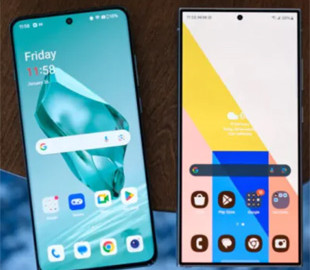How flagship Android smartphones will change in 2025: top 5 trends


Super-capacity batteries, ultra-thin cases, 100 percent water resistance, the smartest chips — smartphones of the coming year will change not only externally, but also internally.
From huge performance gains to bigger batteries and more — here’s what Focus expects from Android-powered smartphones next year.
Much better battery life
One of the most noticeable improvements to expect from next-generation smartphones is much better battery life.
The main reason is the wider adoption of silicon batteries, which offer more capacity in the same physical size than their lithium counterparts. Everyone from Honor and Xiaomi to Oppo and OnePlus are picking up the pace in this segment. For example, the Vivo X200 Pro Mini has a more compact 6.39-inch screen paired with a large 5700 mAh battery, or the Realme GT7 Pro, which has a 6500 mAh battery in a thin body, writes androidauthority.com.
Another reason is that the two leading processors for Android phones, the Snapdragon 8 Elite and the MediaTek Dimensity 9400, are built on TSMC's 3nm process technology. This promises a significant increase in efficiency compared to previous 4nm devices. Qualcomm claims that the new Snapdragon chipset is 44% more efficient than the previous one, while MediaTek says that its processor is 40% more efficient than the older model.
Experts tested the Snapdragon-based ROG Phone 9 Pro and found a significant improvement in battery life compared to the previous generation. Notable gains were achieved during Zoom calls (30%), 4K video playback (30%), and web browsing (46%).
A huge performance leap
Perhaps the biggest improvement for next-gen Android flagships is performance, as the Snapdragon 8 Elite uses a custom Oryon processor, writes tomsguide.com. In our testing, the Realme GT7 Pro didn't show Qualcomm's claimed 45% CPU/GPU improvements, but we experts still saw an impressive performance boost. Meanwhile, the ROG Phone 9 Pro actually matches Qualcomm's CPU claims, but falls a bit short in the GPU category.
MediaTek's Dimensity 9400 doesn't offer the same huge CPU boost, but Oreo's Find X8 Pro tests showed that the phone performed just as well as the ROG Phone 9 Pro and didn't overheat.
Slim smartphones are making a comeback
It seems that ultra-thin smartphones will return in 2025. Apple is already known to be working on the iPhone 17 Air, which will have a thinner design than other iPhone 17 models. South Korean competitor Samsung is also planning to release the Galaxy S25 Slim model a few months after the Galaxy S25 series.
This could provoke a large-scale “war” among smartphone manufacturers as they fight for the attention of customers. However, companies should take into account that ultra-thin devices have a number of disadvantages, such as lower battery capacity, a tendency to overheat, and sacrificing speakers and camera sensors, says The Verge.
In-display fingerprint scanners
The first in-display fingerprint scanners were pretty poor, had slow scanning speeds, and often required multiple attempts. But today, the technology has made significant strides, and some flagship phone makers have switched from optical fingerprint scanners to faster and more reliable ultrasonic solutions. These scanners even allow you to unlock your device if your fingers are damp or wet.
Qualcomm has long been one of the few major suppliers of ultrasonic in-display fingerprint scanners. However, something important happened in the industry earlier this year: Chinese company Goodix announced the commercial availability of its first ultrasonic in-display scanner. The technology debuted in the Vivo X100 Ultra, and since then, a slew of other Chinese flagship phones have come out with the technology, including the Xiaomi 15 series and OnePlus 13. So, we should expect to see more widespread availability of ultrasonic under-display fingerprint scanners in 2025.
Waterproof smartphones
While water resistance is certainly nothing new, almost all recent flagships have received IP68 and even IP69 ratings. Almost all models equipped with the Snapdragon 8 Elite and Dimensity 9400 chipsets are fully water resistant. Some of them also have a higher rating of IP69, which means protection against high-pressure water jets and hot water.
The IP69 rating is not exactly practical for the vast majority of users, but, nevertheless, more and more brands are raising the bar on water resistance. The Chinese OnePlus 13 received IP68/IP69 protection, as did the latest Realme flagship. It can be concluded that even more devices will have a protection rating of at least IP68 in the new year 2025.
Recent Posts
Three zodiac signs, which are favored by powerful guardian angels. Are you one of them
For some people, life is arranged as if they seem to avoid them with a…
Due to Apple tariff rises can raise prices for iPhone smartphones
< img src = "/uploads/blogs/0a/e7/ib-FSA30E4E4EU_4ac9DDA0.jpg" Alt = "due to the growth of Apple tariffs can…
Trump proposes to cut NASA budget by 24%
< img src = "/uploads/blogs/6f/89/ib-FSA5CR680_25CBFBFB6A.jpg" Alt = "Trump proposes to reduce NASA budget by 24%"/>…
Apple significantly simplified the transition from Android to iPhone: Only one action
< img src = "/uploads/blogs/63/9b/ib-1iqiuh8v5_6fc93162.jpg" Alt = "Apple significantly simplified the transition from Android to…
The fraudster in Lviv region promised men to travel abroad and work in the defense
< IMG SRC = "/Uploads/Blogs/12/CC/IB-FSA2TD364_8abe9426.jpg" Alt = "fraudster in Lviv region promised men to travel…
Trump's assassination shot brought journalist New York Times the most prestigious reward
< img src = "/uploads/blogs/71/b5/ib-FS9rhsi9q_715237c6.jpg" Alt = "Trump's assassination frame brought journalist New York Times"/~…